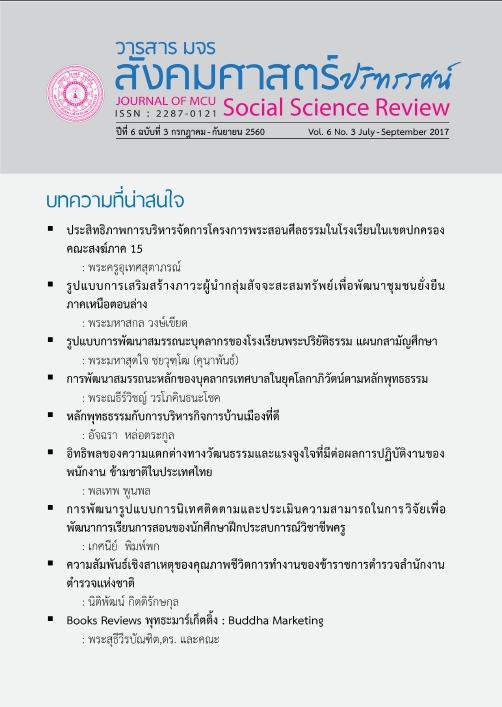การล่าแม่มด ในโลกของโซเชียลมีเดีย
คำสำคัญ:
โซเชียลมีเดีย อินเตอร์เนต ล่าแม่มด การคุกคามทางอินเตอร์เนตสังคม การเมืองบทคัดย่อ
“การล่าแม่มด” ในโลกของโซเชียลมีเดีย เป็นปรากฎการณ์ร่วมสมัยในสังคมไทย ซึ่งมีกลุ่มบุคคลได้รวมตัวกันในโลกไซเบอร์ เพื่อตัดสินเหตุการณ์ที่เกิดขึ้น โดยการสร้างวาทกรรมการเกลียดชังขึ้นมา รวมไปถึงการด่าทออย่างรุนแรง การทำลายชื่อเสียง การเปิดเผยข้อมูลส่วนบุคคลหรือแม้แต่ขู่ทำร้ายในบางกรณี
บทความทางวิชาการนี้ มีวัตถุประสงค์ในการรวบรวมรูปแบบในการล่าแม่มดในโลกของโซเชียลมีเดีย โดยใช้กรณีศึกษา 4 กรณี ทั้งในโลกธุรกิจ โลกมายาหรือโลกบันเทิงและเหตุการณ์ทางการเมือง โดยใช้การวิจัยทางอินเตอร์เนตในแนวปรากฎการณ์วิทยา (phenomenologic study) บนโซเชียลมีเดียที่เป็นที่นิยม เช่น เฟสบุ้ค และเว็ปไซด์พันทิป ซึ่งมีปรากฎการณ์ล่าแม่มดอย่างมาก แม้ว่าเหตุการณ์จะไม่เหมือนกัน แต่เมื่อนำข้อมูลทั้งหมดมาวิเคราะห์ (content analysis) เพิ่อหารูปแบบการโจมตีอย่างมีระบบ สามารถสร้างทฤษฎีจากข้อมูลนี้ได้ (grounded theory study) ผลการวิจัยได้เผยรูปแบบการล่าแม่มดในประเทศไทยที่ชัดเจนและสามารถนำไปประกอบการทำแผนรับมือและคะเนผลกระทบ เพื่อใช้ในการแก้ปัญหาเมื่อการล่าเม่มดในเกิดขึ้นกับตัวหรือองค์กรต่างๆอย่างมีประสิทธิภาพ
เอกสารอ้างอิง
Bartholomew, R. E. (2001). Little Green Men, Meowing Nuns And Head-Hunting Panics: A Study Of Mass Psychogenic Illness And Social Delusion. Jefferson, NC: McFarland & Company, Inc.
Baxter, P., & Jack, S. (2008). Qualitative case study methodology: Study design and
implementation for novice researchers. The Qualitative Report, 13(4), 544- 559.
Gee, J. P. (2014). An Introduction to Discourse Analysis: Theory and Method. New York, NY: Routledge.
Hsieh, H. F., & Shannon, S. E. (2005). Four approaches to qualitative content analysis. Qualitative Health Research, 15(9), 1277-1288.
Kozinets, R.V. (2010). Netnography.In Mansell, R., &Ang, P. H. (Eds.) Theinternation-
Alencyclopedia of Digital Communication and Society. Hoboken, NJ: John Wiley & Sons, Inc.
Mehta, G. (2013). Infinite Ripple-The Social Media Revolution. Bloomington, IN: Xlibris Corporation.
Paireepairit, I. (2012). Free Space of Expression: New media and Thailand’s politics. Berlin,Germany: Fesmedia Asia, Friedrich-Ebert-Stiftung.
Phillips, A. (2014). Journalism In Context: Practice and Theory for The Digital Age. New York, NY:Routledge.
Potts, L., & Harrison, A. (2013). Interfaces as rhetorical constructions: Reddit and 4 chan during the Boston marathon bombings. In Proceedings of The 31st ACM International Conference On Design of Communication, 143-150.
ดาวน์โหลด
เผยแพร่แล้ว
รูปแบบการอ้างอิง
ฉบับ
ประเภทบทความ
สัญญาอนุญาต
ลิขสิทธิ์ (c) 2018 วารสาร มจร สังคมศาสตร์ปริทรรศน์

อนุญาตภายใต้เงื่อนไข Creative Commons Attribution-NonCommercial-NoDerivatives 4.0 International License.
เพื่อให้เป็นไปตามกฎหมายลิขสิทธิ์ ผู้นิพนธ์ทุกท่านต้องลงลายมือชื่อในแบบฟอร์มใบมอบลิขสิทธิ์บทความให้แก่วารสารฯ พร้อมกับบทความต้นฉบับที่ได้แก้ไขครั้งสุดท้าย นอกจากนี้ ผู้นิพนธ์ทุกท่านต้องยืนยันว่าบทความต้นฉบับที่ส่งมาตีพิมพ์นั้น ได้ส่งมาตีพิมพ์เฉพาะในวารสาร มจร สังคมศาสตร์ปริทรรศน์ เพียงแห่งเดียวเท่านั้น หากมีการใช้ภาพหรือตารางหรือเนื้อหาอื่นๆ ของผู้นิพนธ์อื่นที่ปรากฏในสิ่งตีพิมพ์อื่นมาแล้ว ผู้นิพนธ์ต้องขออนุญาตเจ้าของลิขสิทธิ์ก่อน พร้อมทั้งแสดงหนังสือที่ได้รับการยินยอมต่อบรรณาธิการ ก่อนที่บทความจะได้รับการตีพิมพ์ หากไม่เป็นไปตามข้อกำหนดเบื้องต้น ทางวารสารจะถอดบทความของท่านออกโดยไม่มีข้อยกเว้นใดๆ ทั้งสิ้น





